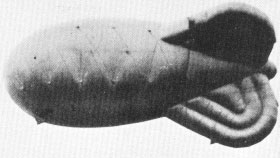 Click for Site Directory
Click for Site DirectoryExperiments
to Evaluate a Low Level Balloon Barrage at Exeter Aerodrome
In July 1940 it was realised that there had been little experience of protecting an operational aerodrome with a low level balloon
barrage (1,000 feet) from Nazi attack.
Between 16th July and 26th August, 26 days of experimentation was held, at Exeter Aerodrome.
The aerodrome had a series of “M” type, 10 feet in diameter, spherical balloons flown in light winds and a series of Brooke and
Cody kites in high winds. It was done to test the barrage’s defensive abilities and to see to what extent it might hinder the fighter pilots
on the aerodrome as they took off and landed.
The wire was 18 S.W.G. piano wire and weighed 6.2 lbs per 1,000 feet.
It was attached to a wooden hand held winch with a week shear link. It was fitted with a dummy bomb to simulate real war conditions.
To warn allied aircraft using the aerodrome of the presence of the balloon cables two pennants were attached to each wire.
The balloon spacing was set at 50 to 100 yards apart. Winds over 10.m.p.h. were found to cause problems with the balloons which in gusting
conditions were sometimes blown onto the ground.
When the wind dropped to a lull the Kites also fell out of the sky and often got tangled up in trees.
The balloons were not of good quality and lost hydrogen in various ways.
When not in use the balloons were stored in a convenient sunken garden with high hedges which acted as a natural windbreak.
The experiment was met with mixed observations.
There was negative criticism from the Aerodrome commander. It was shown that with a small crew of around 6 men the barrage could be flown
for 90% of the time. Wing Commander Dewar said that this type of barrage defence should be considered at other aerodromes.
The aerodrome pilots were concerned that the balloons revealed the location of the aerodrome.
Dewar felt that the pilots concern that the balloons acted as a landmark were not relevant, as the Nazis knew where it was anyway.
In any case it would
be quite easy to set up a distracting decoy balloon barrage.
The aerodrome pilots were of the opinion that no Nazi aircraft would fly in at less than 1,000 feet. However on the previous
18th August the Kenley Aerodrome was attacked by two Dornier 17 aircraft and both were shot down by the P.A.C (Parachute & Cable System).
It was pointed out that these devices fired a rocket that took a parachute and cable up to 500 feet which then snared the plane.
It was felt that this proved that Nazi aircraft would and had flown in low to attack an aerodrome.
It was recommended that the experiment be continued with smaller specially made balloons copied from the MkVI design, which would be
more stable. As far
as I can determine the experiment was not repeated.
Peter Garwood 2024